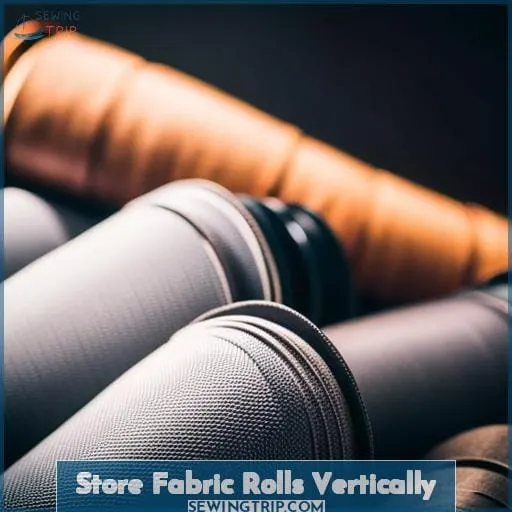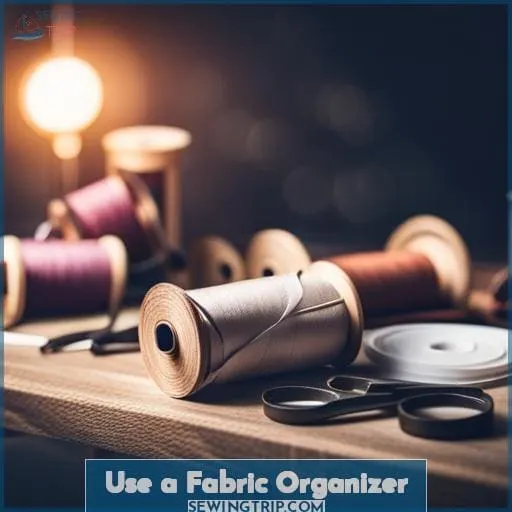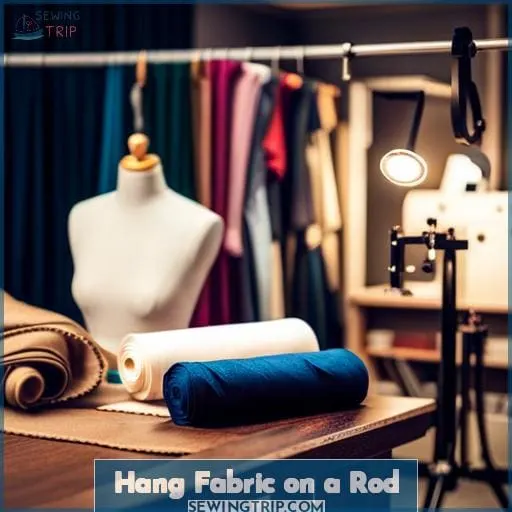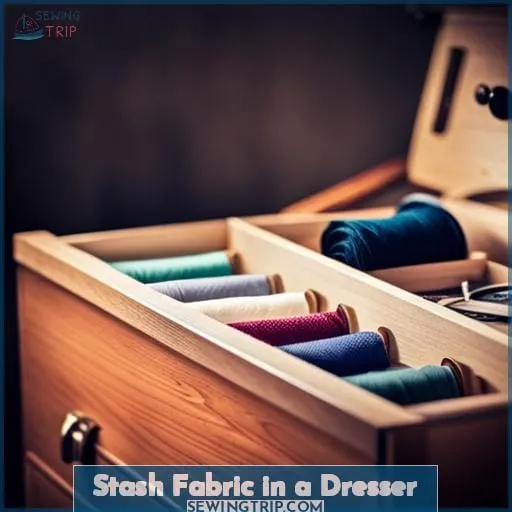This site is supported by our readers. We may earn a commission, at no cost to you, if you purchase through links.
 Got a fabric stash that’s out of control? Learn how to store fabric for sewing with these 10 clever tips for organizing your fabric stash.
Got a fabric stash that’s out of control? Learn how to store fabric for sewing with these 10 clever tips for organizing your fabric stash.
- Sort your fabrics by type, weight, and color.
- Use clear, labeled bins or drawers to store your fabrics.
- Hang your fabrics on a rod or in a garment bag.
- Fold your fabrics and store them in a drawer or on a shelf.
- Use a fabric organizer to keep your fabrics organized and easy to find.
- Stack your fabrics in a cube organizer.
- Roll your fabrics and store them in a tote bag or suitcase.
- Use a garment rack to store your fabrics.
- Hang your fabrics on a tension rod in your closet.
- Use a wall-mounted fabric organizer to keep your fabrics organized and out of the way.
Table Of Contents
- Key Takeaways
- Don’t Store Fabric by Color
- Store Fabric Rolls Vertically
- Use Clear Plastic Totes
- Fold Fabric Ahead of Time
- Label Fabric With Yardage
- Store Fabric in a Climate-Controlled Area
- Use a Fabric Organizer
- Hang Fabric on a Rod
- Stash Fabric in a Dresser
- Store Fabric in a Cabinet
- What is a Product Manager?
- Frequently Asked Questions (FAQs)
- Conclusion
Key Takeaways
- Sort fabric by type, weight, and color.
- Store fabric rolls vertically and label them with the fabric type and yardage.
- Fold fabric ahead of time and stack and organize it by type and size.
- Store fabric in a climate-controlled area, protecting it from sunlight, moisture, and pests.
Don’t Store Fabric by Color
Don’t store your fabric stash by color; instead, allocate separate areas for specific types of fabric.
This will help you keep track of your fabrics and find what you’re looking for quickly.
It will also prevent sunlight fading concerns and humidity issues.
If you have a lot of fabric scraps, consider storing them in a separate container or bin.
Prewashing fabric before storing it can help to prevent fabric dust accumulation.
Store Fabric Rolls Vertically
Storing fabric rolls vertically maximizes space and makes them easy to access.
Use tension rods, a garment rack, a pegboard, a ladder, or a curtain rod to hang fabric rolls vertically.
Label each roll with the fabric type and yardage so you can easily find what you’re looking for.
Use Clear Plastic Totes
Once you’ve stored your fabric rolls vertically, use clear plastic totes to keep them organized.
Clear plastic totes will help to prevent sunlight damage and protect your fabrics from dust and other debris.
They also make it easy to see what fabrics you have and to access them quickly.
You can stack the totes on top of each other to save space, and you can label each tote with the type of fabric it contains.
This will help you to keep your fabric stash organized and easy to find.
Fold Fabric Ahead of Time
Just like with storing your fabric rolls vertically, folding your fabric ahead of time will save you a lot of time and hassle in the long run.
- Keep selvage edges together. This will help to prevent fraying and make your fabric look neater.
- Fold fabric around a ruler. This will help you create even folds and ensure that your fabric is the correct width.
- Fold fabric into 4 ½, 5, or 6 widths. This will create a uniform stack of fabric that’s easy to store and access.
- Stack and organize fabric by type and size. This will help you to quickly find the fabric you need for your next project.
By following these simple tips, you can easily organize your fabric stash and keep it looking neat and tidy.
Label Fabric With Yardage
Once you’ve folded your fabric, it’s time to label it with the yardage. This will help you keep track of how much fabric you have and what projects you can use it for.
You can use a marker to write the yardage on the selvage edge of the fabric, or you can use fabric paint or chalk to mark it.
You can also use tape to create a label for the fabric. Be sure to label the fabric with the correct yardage so you don’t end up using too much or too little fabric for your projects.
Store Fabric in a Climate-Controlled Area
To keep your fabric in good condition, store it in a climate-controlled area.
This means:
- Avoiding sunlight
- Preventing moisture
- Keeping bugs out
You can also use fabric storage bags to protect your fabric from dust and dirt.
By following these tips, you can keep your fabric fresh and organized for years to come.
Use a Fabric Organizer
In addition to storing your fabric in a climate-controlled area, you should also use a fabric organizer.
A fabric organizer can help keep your fabrics neatly organized and easily accessible for all of your sewing projects.
There are various types of fabric organizers available, from hanging garment racks with multiple tiers to hooks that can be attached to walls or doors.
You can also find DIY ideas for creating your own fabric organizer using materials like PVC pipes or wooden dowels.
If you prefer convenience, there are plenty of options on Amazon and Walmart that offer pre-made fabric organizers in different sizes and designs to suit your storage needs.
Another option is utilizing a sewing cabinet with built-in storage compartments specifically designed for organizing fabrics and supplies.
Whatever type of fabric organizer you choose, it will make the process of finding the perfect piece much simpler while keeping everything neat and tidy.
Hang Fabric on a Rod
Hang your fabric on a rod to maximize storage space and keep it easily accessible.
Using a tension rod or even a shower curtain rod, you can create additional hanging space in your sewing room or any other area of the house.
Install the tension rod in a closet, pantry, basement, or any empty wall space where you have enough height for longer pieces of fabric.
Simply adjust the length of the tension rod to fit your chosen location and hang fabric rolls directly onto it. This method works especially well for storing large yardages and keeping them wrinkle-free.
By hanging fabric on rods, you not only save valuable shelf or drawer space but also make it easier to see what fabrics you have available at all times.
You can organize different types of fabrics by color or project so that they’re neatly displayed and ready for use whenever inspiration strikes. Plus, this method adds an aesthetic element to your sewing room organization by turning colorful bolts into decorative accents on display.
Incorporating this simple yet effective storage solution will ensure that your precious fabrics stay organized while remaining easily accessible whenever creativity calls.
Stash Fabric in a Dresser
With a few simple adjustments, you can stash fabric in a dresser to maximize space and keep your stash organized.
- Use shallow drawers to prevent fabric from bunching up.
- Use comic book boards to keep fabric flat and wrinkle-free.
- Use clear bins to easily identify fabrics.
- Avoid plastic bins, as they can trap moisture and cause fabrics to mildew.
- Store fabric in a climate-controlled area away from direct sunlight.
Store Fabric in a Cabinet
If you have a lot of fabric, storing it in a cabinet can be a great way to keep it organized and accessible.
- Use plastic bins to keep your fabric organized and protected from sunlight.
- Use a rod to hang fabric that’s too bulky to fit in bins.
- Hang fabric in a file cabinet to keep it organized and dust-free.
- Use drawer dividers to keep your fabric organized by type or project.
- Label your bins and drawers so you can easily find what you’re looking for
What is a Product Manager?
After storing fabric in a cabinet, you can learn more about what a product manager does by visiting their website.
A product manager is responsible for the overall success of a product, from its conception to its launch.
They work with stakeholders to define the product’s vision, gather requirements, and create a roadmap.
They also work with engineers, designers, and marketers to bring the product to life.
To become a product manager, you typically need a bachelor’s degree in computer science, engineering, or business.
Product managers typically earn a salary of $100,000-$150,000 per year.
Frequently Asked Questions (FAQs)
What is the best way to store fabric scraps?
The best way to store fabric scraps is to:
- Roll them up.
- Store them in clear plastic bags or bins.
This will keep them organized and easy to find.
How do I prevent fabric from getting dusty?
To prevent fabric from getting dusty, you can:
- Store it in a sealed container or bag with a desiccant pack.
- Hang it in a closet or other space with good air circulation.
Should I prewash fabric before storing it?
Prewashing fabric before storing it isn’t necessary, but it can help to:
Make the fabric more durable
How do I store fabric that is prone to wrinkling?
Worried about your fabric wrinkling?
Roll it up with tissue paper between the layers and store it in a plastic bag with a silica gel packet.
What is the best way to store fabric in a humid climate?
In a humid climate, it’s important to avoid closed plastic bins for fabric storage as they may lead to mold.
Instead, consider utilizing open shelving or breathable containers to prevent moisture buildup and maintain the quality of your fabrics.
Conclusion
With these 10 clever tips, you can finally get your fabric stash under control and start sewing with confidence!
- Sort your stash by type, color, and pattern.
- Label your fabric with the fiber content, weight, and width.
- Store your fabric in a cool, dry place.
- Use a fabric organizer to keep your fabric organized.
- Donate or sell fabric that you no longer need.
- Take a sewing class or workshop to learn new skills and techniques.
- Join a sewing club or group to meet other sewists and get inspiration.
- Set realistic goals for yourself and don’t get discouraged if you don’t finish every project.
- Be patient and enjoy the process of sewing.
- Celebrate your successes and share your work with others.

















